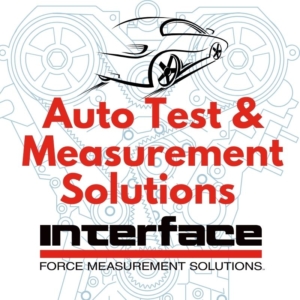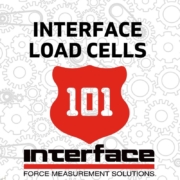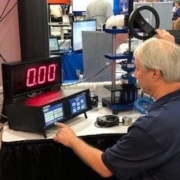Advancing Auto Testing with Interface Measurement Solutions
 What classifies as the automotive industry involves a complex and dynamic mix of suppliers, makers and designers of all types of vehicles, as well as prototypes of the changing demands and requirements of consumers both big and small. Whether we look at where we are today with hybrid and electric motors, or autonomous rigs and people movers in test now, one thing that is constant is Interface’s role in providing vital measurement solutions for testing and real-time performance monitoring in the automotive and vehicle markets.
What classifies as the automotive industry involves a complex and dynamic mix of suppliers, makers and designers of all types of vehicles, as well as prototypes of the changing demands and requirements of consumers both big and small. Whether we look at where we are today with hybrid and electric motors, or autonomous rigs and people movers in test now, one thing that is constant is Interface’s role in providing vital measurement solutions for testing and real-time performance monitoring in the automotive and vehicle markets.
Automotive is one of the industries in which Interface has worked with since the introduction of our first load cells more than five decades ago. Force and torque measurement is critical to testing at every stage of design and manufacturing. Our sensor solutions, instrumentation and accessories are used across all facets of component development, including the testing of engines and exterior bodies, tires, batteries, fuel pumps and more.
Interface products are used for crash walls, brake testing, energy storage tests in the lab, seat belt and headrest testing, just to name a few. The fact is torque and force play a major role in making the vehicle move and ensuring it’s safe for drivers and pedestrians alike. Interface is showcasing some of these solutions at the upcoming Automotive Test Expo. Registration to attend is free.
As the industry evolves, so do we. In fact, our advanced product AxialTQ was created for the automotive industry for testing of EVs. This revolutionary torque transducer is now used in all types of line production, assembly and part, including:
- Internal Combustion Engine (ICE) Lab Testing and End of Line (EOL) Testing
- Drivetrain Lab Testing
- Automotive Accessory Lab Testing
- Electric Vehicle (EV) Motor EOL and EV Lab Testing
For more about this dynamic product, you can watch our latest AxialTQ Webinar here.
Interface supplies high quality, precision load cells to automotive manufacturers, including custom one-off sensors and special application-specific designs. Standard off-the-shelf models such as our 2400 series , our 3200 series Stainless Steel LowProfile™ Load Cells, and our WMC Miniature Load Cell family are popular with machine builders and used anywhere a rugged stainless steel load cell is required.
Research and development facilities with precision applications favor our 1200 Series LowProfile™ Load Cells with their special moment compensated design. These are used in auto manufacturer assembly lines in a variety of production monitoring and verification applications. Our exceedingly accurate LowProfile™ Load Cells have been used in NASCAR and IndyCar garages for testing individual springs and entire vehicle suspensions.
A moment compensated Interface load cell has as much as 1,000 times less error from side load or moment as our competitor’s products. And many of our sensors feature 10x mechanical overload protection, which helps protect against unintended loads. Our Model BPL Load Cell is a very LowProfile™ load cell used for measuring force on gas, brakes or clutch pedals.
With a wide range of automotive vehicle load cell sensors, force and torque measurement capabilities, and features such as moment compensation, temperature compensation, and mechanical overload protection, Interface can help you design a solution perfect for your automotive application. In fact, here are a few examples of our products in action.
Airbag Connector Testing
Testing airbag connectors functionality is needed ensure perfect deployment to meet the ultimate test of saving lives. There are eight to twelve connectors installed in each vehicle, and tests are needed to be made in order to clarify the connectors are working effectively. The amount of force needs to be tested in order to see when an electrical current has triggered use. Utilizing the WMC Sealed Stainless Steel Miniature Load Cell to the actuator of the test rig. The airbag connector is held in place at the bottom of the test rig. Forces are applied and measured using the 9330 High Speed Data Logger as the connector is pushed down to latch together. Read more about this use case.
Seat Testing
During testing there was consistent overloading and replacing of the single-axis load cells. After a thorough inspection, it was discovered that this was due to bending moments that had never been quantified so a multi-axis sensor was defined as the best solution. An Interface Model 6A68C 6-Axis load cell was installed in their existing test machine. The 6-Axis Sensor was intentionally oversized allowing the customer to measure the unidentified bending moments while preventing any damage. Data Acquisition and Amplifier BX8 was used to graph, log, & store the data collected at the sensor. Read more here.
Automotive Headrest Testing
When a manufacturer for automotive head rests wanted to test the durability of their products by conducting several fatigue tests and force tests on the head rests to make sure it meets durability and high-quality standards, Interface was able to help. The solution was to install Model 1000 Fatigue-Rated LowProfile™ Dual Bridge Load Cell to the customer’s actuator mechanism. This load cell is perfect for fatigue testing and reports highly accurate results through the fatigue cycling. The results are collected by using the SI-USB4 4-Channel USB Interface Module, which synchronizes the data directly from the load cell and the string pot (for measuring distance) to the customer’s computer. Using this system, the head rest manufacturer was able to get highly accurate data through the fatigue testing cycle. Watch the testing video in action!
Engine Dynamometer
Internal combustion engines are by far the most common power source for land vehicles. From a 2-stroke motor in a lawn mower, to a V-8 stock car engine, horsepower and torque are the benchmarks of engine performance. Engine manufacturers and aftermarket suppliers use an engine dynamometer (dyno for short) to accurately measure an engine’s performance. An engine dyno isolates an engine’s power output to help quantify its overall performance, applying a load directly to the engine and utilizing a load cell to measure the torque absorbed by the loading mechanism. Horsepower is then calculated using the torque and RPM of the engine. To conduct this test, a precision S-Type Load Cell is attached to a torque arm which “feels” the torque from the engine loading system. The Interface Model SSMF is a great choice because it is fatigue-rated for a number of fully reversed cycles and is environmentally sealed to withstand harsh environments. Utilizing the Model CSC Signal Conditioner provides a clear signal to a data-acquisition system. Using this test solution, the load cell reacts precisely with the amount of torque being produced by the engine and provides accurate signals to the data-acquisition system. Engineers are then able to analyze the power transfer for the engine and optimize for performance. Read more about this solution here.







